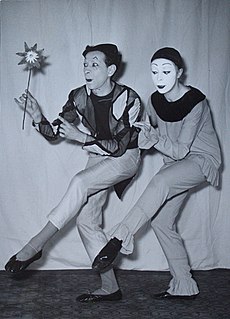Mime artist: Difference between revisions
Someone can certainly revert this is they can show that Captain Picard was, in fact, a mime. |
No edit summary |
||
| Line 6: | Line 6: | ||
[[Image:Jean + Brigitte Soubeyran Im Zirkus.JPG|thumb|230px|Mimes Jean and Brigitte Soubeyran]] |
[[Image:Jean + Brigitte Soubeyran Im Zirkus.JPG|thumb|230px|Mimes Jean and Brigitte Soubeyran]] |
||
A '''mime artist''' is someone who uses '''mime''' as a theatrical medium or as a [[performance art]], involving the acting out of a story by a [[mime artist]] through body motions, without use of [[speech]]. In earlier times, in English, such a performer was referred to as a '''[[mummer]]'''. Miming is to be distinguished from [[silent comedy]], in which the artist is a seamless character in a film or sketch. |
A '''mime artist''' is someone who uses '''mime''' as a theatrical medium or as a [[performance art]], involving the acting out of a story by a [[mime artist]] through body motions, without use of [[speech]]. In earlier times, in English, such a performer was referred to as a '''[[mummer]]'''. Miming is to be distinguished from [[silent comedy]], in which the artist is a seamless character in a film or sketch.kelli luvs mimes!!!!!!!!!!!!!!!!! |
||
==History == |
==History == |
||
Revision as of 03:58, 7 July 2008

A mime artist is someone who uses mime as a theatrical medium or as a performance art, involving the acting out of a story by a mime artist through body motions, without use of speech. In earlier times, in English, such a performer was referred to as a mummer. Miming is to be distinguished from silent comedy, in which the artist is a seamless character in a film or sketch.kelli luvs mimes!!!!!!!!!!!!!!!!!
History
The performance of pantomime originates at its earliest in ancient Greece; the name is taken from a single masked dancer called Pantomimus, although performances were not necessarily silent. In Medieval Europe, early forms of mime such as mummer plays and later dumbshows evolved. In early nineteenth century Paris, Jean-Gaspard Deburau solidified the many attributes that we have come to know in modern times — the silent figure in whiteface.
Marcel Marceau was perhaps the most well-known modern mime.
In film
Prior to the work of Etienne Decroux there was no major treatise on the art of mime, and so any recreation of mime as performed prior to the twentieth century is largely conjecture, based on interpretation of diverse sources. However, the twentieth century also brought a new medium into widespread usage: the motion picture.
The restrictions of early motion picture technology meant that stories had to be told with minimal dialogue which was largely restricted to intertitles. This often demanded a highly stylized form of physical acting largely derived from the stage. Thus, mime played an important role in films prior to advent of talkies (films with sound or speech). The mimetic style of film acting was used to great effect in German Expressionism film.
Silent film comedians like Charles Chaplin, Harold Lloyd and Buster Keaton learned the craft of mime in the theatre but through film had a profound influence on mimes who work in live theatre even decades after their death. Indeed, Chaplin may be the best documented mime in history.
The famous French comedian, writer and director Jacques Tati achieved his initial popularity working as a mime, and indeed his later films had only minimal dialogue, relying instead on many subtle expertly choreographed visual gags. Tati, like Chaplin before him, would mime out the movements of every single character in his films and ask his actors to repeat them.
Another French actor who began his career as a mime was Jean-Louis Barrault. In the film Les Enfants du Paradis he portrayed the famous 19th century mime Jean-Gaspard Deburau.
In non-Western theatre traditions
While most of this article has treated mime as a constellation of related and historically linked Western theatre genres and performance techniques, analogous performances are evident in the theatrical traditions of other civilizations.
Classical Indian musical theatre, although often erroneously labeled a "dance," is a group of theatrical forms in which the performer presents a narrative via stylized gesture, an array of hand positions, and mime illusions to play different characters, actions, and landscapes. Recitation, music, and even percussive footwork sometimes accompany the performance. The Natya Shastra, an ancient treatise on theatre by Bharata Muni, mentions silent performance, or mukhabinaya.
Notable mime artists or movement theatre artists

- Alejandro Jodorowsky
- Achille Zavatta
- Adrian Pecknold
- Bill Bowers
- Bill Irwin
- Blue Man Group
- Buster Keaton
- Carlos Martínez
- Charles Chaplin
- Daniel Stein
- Dario Fo
- Ennio Marchetto
- Etienne Decroux
- Gene Sheldon
- George L. Fox
- Harpo Marx (The Marx Brothers)
- Henryk Tomaszewski
- Jacques Lecoq
- Jacques Tati
- Janet Carafa
- Jean-Gaspard Debureau
- Jean-Louis Barrault
- Jean-Jacques Menais
- Ladislav Fialka
- Lenka Pichlíková – Burke
- Lon Chaney
- Marcel Marceau
- Mummenschanz
- Oleg Popov
- Pablo Zibes
- Pan Tau
- Samuel Avital
- Samy Molcho
- Shields And Yarnell
- Stan Laurel
- Thomas Leabhart
- Tik and Tok
- Tony Montanaro
- Wolfe Bowart
See also
- Corporeal mime
- Dumbshow
- Floating (dance)
- Liquid dancing
- Mummers Play
- Popping (dance)
- Physical theatre
Educational
External links
- www.pantomimes-mimes.com
- The world of mime theatre International mime theatre information, including a library, resources, performer contacts, and events calendar
- International mime and physical theatre centre, researches, creation, training.
